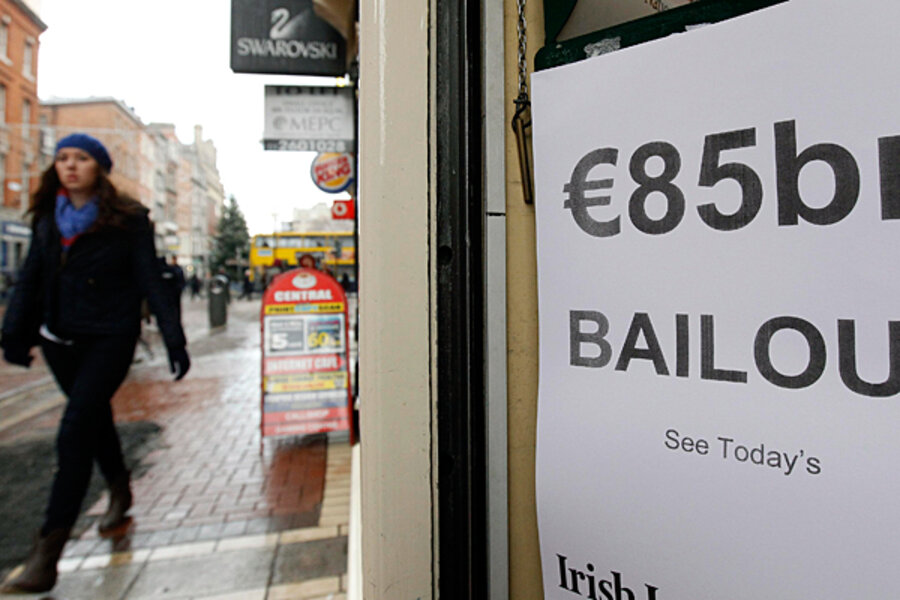Irish protest – sort of – as bailout details emerge
Loading...
| Dublin, Ireland
Details emerged Sunday of the joint European Central Bank and International Monetary Fund plan to prop-up Ireland’s economy in an effort to keep the euro afloat.
The package, designed to shore up the country’s nationalized banks, totals €85 billion ($112.5 billion) and will require Ireland to repay the money at an average interest rate of 5.8 percent over the next seven and a half years.
The plan includes €10 billion for recapitalization of the banks, a further €25 billion to held for banking contingencies, and €50 billion to run the county’s public finances.
Prime Minister Brian Cowen, leader of the Fianna Fáil party, said it was the “best deal available” to the country. But opposition figures reacted to the terms of the deal with dismay.
Michael Noonan, the finance spokesperson for main opposition party Fine Gael, said the deal was “a hugely disappointing result for the country." Labor party finance spokesperson Joan Burton said the country was “banjaxed” – Irish slang for "ruined."
Gerry Adams, leader of Sinn Féin, also described it as a bad deal. “The decision to protect bondholders is disgraceful. The costs of this deal to ordinary people will result in hugely damaging cuts,” he said.
Interest rate objections
The principal objections are to the interest rate imposed as part of the deal.
Irish Finance Minister Brian Lenihan defended the 5.8 percent rate as fair, saying that it was equivalent to the 4.5 percent interest rate imposed on Greece for its bailout in the spring. Ireland must pay a higher rate, according to the government, because its loan extends four and a half years longer than Greece's three-year loan, which means the Irish government will be paying yearly interest on a smaller amount of debt.
“This is a very good deal for Ireland in current circumstances,” IMF mission chief Ajai Chopra of the bailout terms.
Stephen Kinsella, economist at the University of Limerick, says the interest rate is high but that setting it was a balancing act for the ECB and IMF.
“The interest rate has to be low enough to ensure Ireland has some chance of paying it back, but it also has to be high enough to push Ireland back into the private sovereign debt market,” he says.
Dr. Kinsella says the deal is a good one for the country given the circumstances – but he notes the burden it places in Ireland. That burden is fueling public discontent ahead of a general election expected within two months. The Green party recently announced its intention to pull out of the coalition government come January.
David Cochrane, who runs the Web discussion forum politics.ie, says the Irish public is both stunned and confused by the events of the last few weeks and places the blame at the government’s feet.
“The government has not communicated what it’s doing,” he says.
“First they denied a bailout was being negotiated, and then we find out it is happening. Over the weekend, they have failed to communicate the details of what is being negotiated,” he says.
Confused public
Other than opposition to the government and bailout, there is little sense of a plan of action that could be agreed on.
Despite frigid weather, an estimated 100,000 people took to the streets of Dublin on Saturday to signal their opposition to the bailout and proposed cuts to the minimum wage but the protest was far from angry.
“Never have I seen so many Irish people walk the walk of protest with so little sense of purpose or anger,” says Steven Daley, an unemployed worker who traveled from Mayo county in Western Ireland to attend the protest. "There was no sense of any meaningful direction.”
The protest was organized by the Irish Congress of Trade Unions (ICTU), but demonstrators booed ICTU chief Jack O’Connor when he attempted to make a speech.
Ireland’s labor unions are considered by many, even on the left, to have been acting hand-in-glove with the government throughout the boom years due to the so-called social partnership policy that saw industrial action avoided in favor of regular pay rises for public employees.





